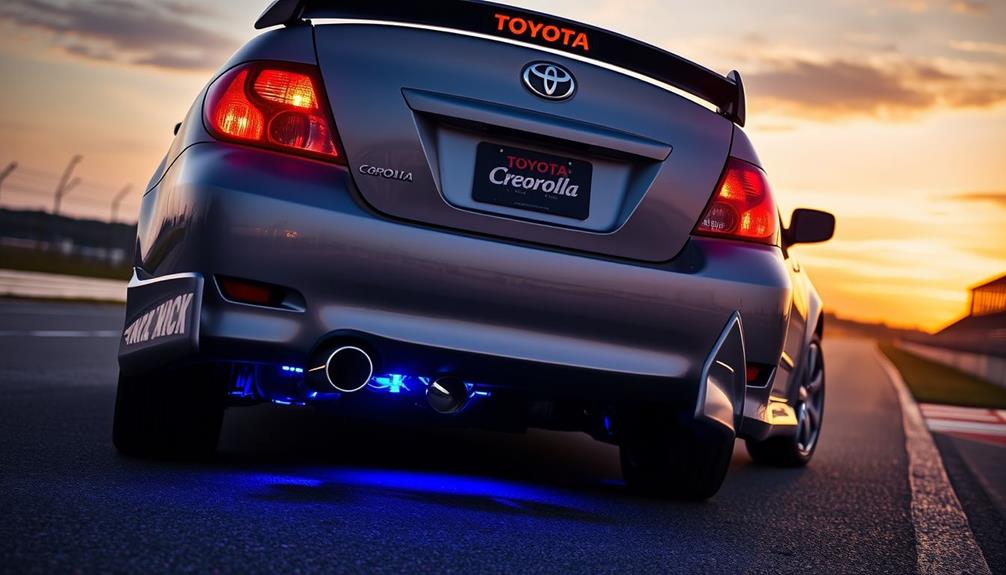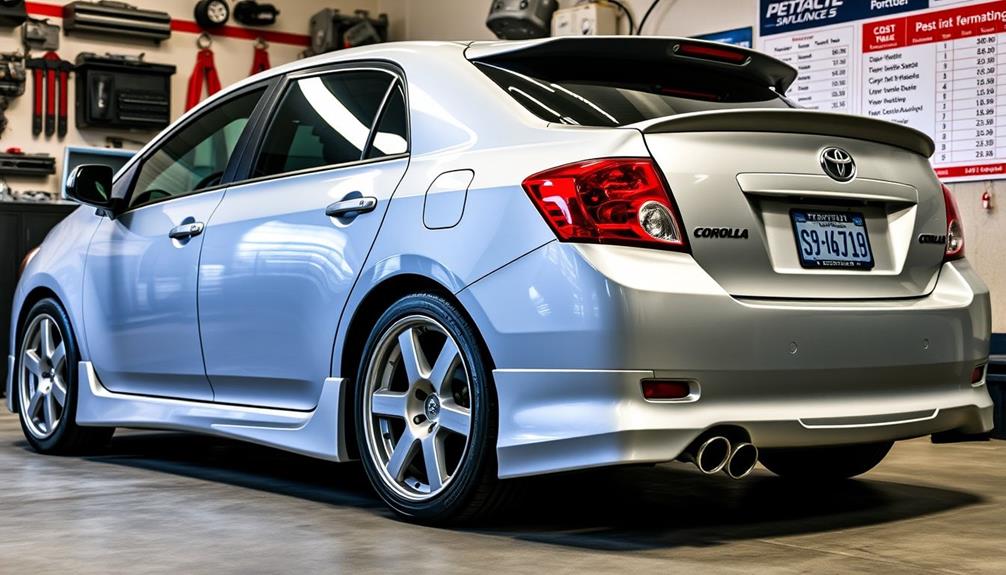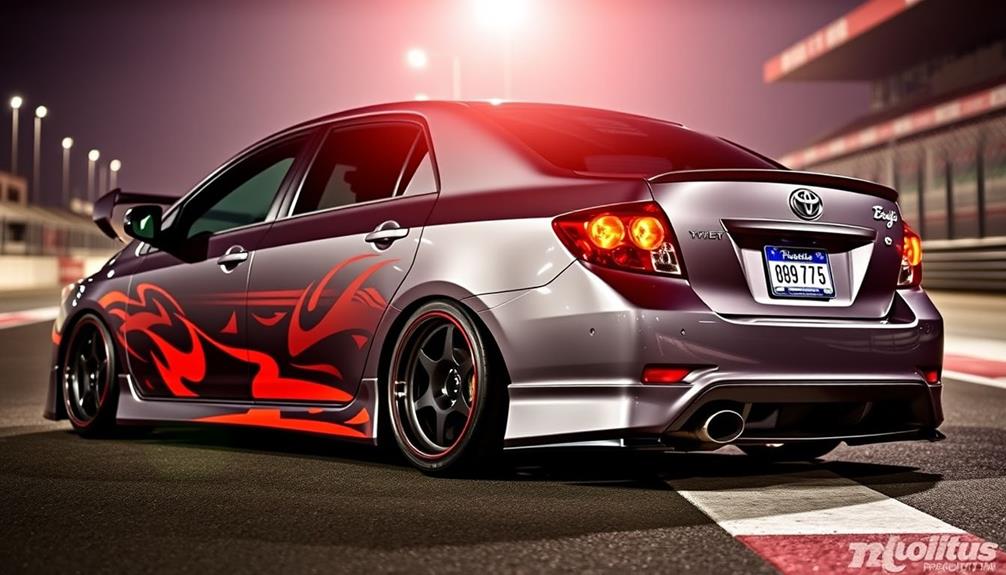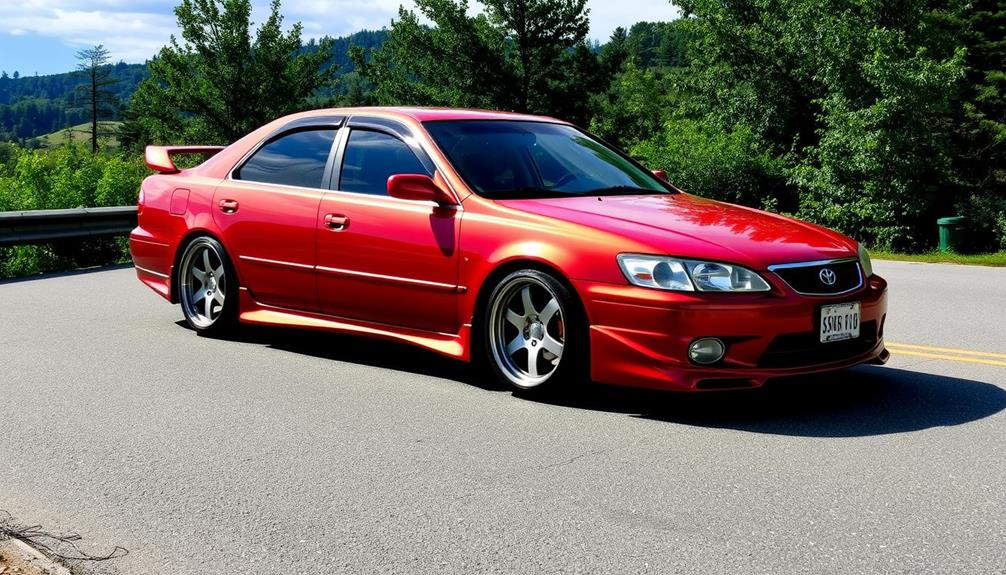Tuning your 2007 Toyota Corolla can drastically enhance its performance and turn it into a fun little beast on the road. Start with a cold air intake for an easy gain of about 7 horsepower. Pair it with a cat-back exhaust system to improve flow and sound. For even better results, consider an AMT tuning box, which can add up to 28 horsepower with a proper tune. Don't forget short throw shifters for quicker gear changes, too. Explore the tuning community to find the best mod options, and you'll discover even more ways to boost your Corolla's performance.
Key Takeaways
- Upgrade to a cold air intake for an estimated gain of 7 horsepower and improved engine sound.
- Install a cat-back exhaust system to enhance exhaust flow and achieve a more aggressive sound.
- Consider an AMT tuning box for significant performance boosts, offering up to 28 HP with proper tuning.
- Utilize short throw shifters for improved gear change responsiveness and enhanced driving control.
- Engage with the automotive community to discover effective tuning options and share modification experiences.
Performance Modifications Overview
When considering performance modifications for your 2007 Toyota Corolla, you'll find that these upgrades can greatly enhance your driving experience. One popular option is the cat-back exhaust system, which not only improves exhaust flow but also adds a more aggressive sound to your ride. This upgrade can lead to a noticeable increase in power, allowing your Corolla to perform better on the road.
While some modifications can be pricey, many enthusiasts believe the benefits justify the costs. You might also consider an engine tuning option, like the AMT tuning box, which can yield significant horsepower gains—up to 28 HP with Stage 2 tuning.
Additionally, short throw shifters provide a sportier feel during gear changes, giving you better control and responsiveness.
Engaging with the car enthusiast community can help you learn more about the best performance modifications for your Corolla, allowing you to prioritize what fits your driving style and preferences. Each upgrade contributes to a more enjoyable and dynamic driving experience, so take your time exploring your options and make your Corolla truly yours.
Cold Air Intake Benefits

A cold air intake system can greatly boost your 2007 Toyota Corolla's performance, offering an estimated gain of around 7 horsepower without requiring an engine tune. By drawing in cooler air from outside the engine compartment, these systems increase the density of the air entering your engine, leading to better combustion and more power.
Even though you might consider other modifications, a cold air intake is a foundational upgrade that enhances overall vehicle performance.
In addition to power gains, these systems improve engine sound, making your driving experience more enjoyable and engaging. You'll notice a throaty growl that adds excitement to every drive.
However, it's vital to choose the right type of intake. While short ram intakes are popular, they can lead to reduced power by drawing in warmer air. A quality cold air intake not only complements other modifications, such as exhaust upgrades, but also maximizes your Corolla's horsepower and driving enjoyment.
Investing in a cold air intake system is a smart move if you're serious about tuning your Corolla. It's a straightforward upgrade that delivers noticeable benefits, making your compact car feel more like a performance beast.
Exhaust System Upgrades

Upgrading your exhaust system can take the performance of your 2007 Toyota Corolla to the next level, complementing the benefits of a cold air intake. A Borla exhaust system, priced around $350, can markedly enhance sound quality while improving exhaust flow, resulting in better overall performance.
With this upgrade, you'll notice improved horsepower and torque, making your Corolla feel more alive on the road.
Consider adding options like DNA headers for a cost-effective alternative that optimizes exhaust efficiency. Not only do these upgrades boost your car's power, but they also provide a more aggressive and enjoyable engine note during acceleration.
The right exhaust system can greatly enhance your vehicle's responsiveness and throttle response, making your driving experience far more engaging.
Sound quality is vital for enthusiasts, so it's important to find an exhaust setup that balances loudness and a pleasant driving tone.
By selecting a well-chosen exhaust system, you'll guarantee that your Corolla not only performs better but also sounds fantastic while doing it.
Make this vital upgrade, and you'll transform your compact car into a true performance beast.
Engine Tuning Options

When it comes to engine tuning options for your 2007 Toyota Corolla, tuning boxes and engine mapping techniques are key players.
You can greatly enhance performance with the right setup, releasing impressive gains in horsepower and torque.
Let's explore how these options can transform your driving experience.
Tuning Boxes Overview
Tuning boxes are increasingly popular among enthusiasts looking to boost their 2007 Toyota Corolla's performance. Devices like the AMT tuning box connect easily to your car's OBD2 port, allowing you to make significant performance enhancements through adjustable air-fuel ratios and timing adjustments.
If you opt for a Stage 1 tune, you could see gains of around 16 horsepower and 11 ft-lbs of torque. For those willing to go further, a Stage 2 tune combined with additional modifications can provide up to 28 horsepower and 21 ft-lbs of torque.
Besides raw power, tuning boxes can enhance your driving experience with features like pops and bangs during acceleration, adding excitement to your ride.
One of the best parts? Engine tuning with a tuning box is often a more affordable alternative compared to pricier modifications, delivering substantial power increases without requiring extensive engine rebuilds or turbo installations.
Don't forget to engage with the tuning community! They can offer invaluable insights and experiences that help you choose the right tuning options, ensuring you maximize your Corolla's performance potential.
Engine Mapping Techniques
Engine mapping techniques release your 2007 Toyota Corolla's full potential by fine-tuning essential parameters like air-fuel ratios and ignition timing.
By utilizing tuning boxes such as the AMT, you can achieve impressive gains with Stage 1 tunes, yielding up to 16 HP and 11 ft-lbs of torque. If you're after more power, Stage 2 tunes can push those numbers even higher, especially when combined with other modifications.
Here are key elements of engine mapping techniques:
- Real-Time Adjustments: Using an OBD2 tuning connection allows you to make real-time adjustments, giving you control over your vehicle's performance characteristics.
- Customization: Tailor your Corolla's engine map to suit your driving style, whether you prefer a smoother ride or more aggressive acceleration.
- Enhanced Features: Some tuning options offer exciting features like pops and bangs during acceleration, adding a thrilling element to your driving experience.
Engaging in community discussions about engine mapping can also provide valuable insights.
You'll learn ideal tuning strategies and discover which products work best for your Corolla, making your tuning journey even more rewarding.
Performance Gains Explained
Releasing the full potential of your 2007 Toyota Corolla is easier than you might think, thanks to various tuning options available.
One of the most effective ways to boost performance is by using an AMT tuning box. With a Stage 1 tune, you can gain approximately 16 HP and 11 ft-lbs of torque, giving your compact car a noticeable kick.
If you're looking for even more power, consider a Stage 2 tune, which can yield up to 28 HP and 21 ft-lbs of torque, especially when paired with additional modifications.
These tuning adjustments optimize your Corolla's air-fuel ratios and timing, enhancing overall engine performance and responsiveness.
Plus, you can enjoy features like pops and bangs during acceleration, adding an exciting auditory experience to your drive.
Investing in engine tuning not only provides significant performance enhancements but can often rival the power increase of more extensive modifications, like turbo kits.
Community Feedback and Insights

Community insights are invaluable when it comes to modding your 2007 Toyota Corolla. Engaging with fellow enthusiasts can greatly enhance your tuning journey. By sharing personal experiences, you can discover what truly works and what doesn't.
Here are three key takeaways from the community that can guide your modifications:
- Cold Air Intakes vs. Short Ram Intakes: Discussions on forums clarify misconceptions about these options. Many users emphasize the improved airflow and performance gains from cold air intakes.
- Exhaust Sound Quality: Insights reveal that sound is just as important as performance. Many modders recommend brands like Borla, citing that satisfying sound quality plays a vital role in their purchasing decisions.
- Tuning Options: The AMT tuning box is frequently praised for delivering considerable horsepower and torque increases. Enthusiasts often share before-and-after metrics, helping others make informed choices.
Importance of VVTi Solenoids

Often overlooked, VVTi solenoids are vital for optimizing valve timing in your 2007 Toyota Corolla, directly influencing engine performance and efficiency. These components adjust the timing of your intake and exhaust valves, which can lead to improved throttle response and a better overall driving experience. While some enthusiasts argue that the performance gains are significant, others believe the impact is minimal.
It's important to weigh the upgrade carefully. A high-quality set of quantum VVTi solenoids may cost around $500-$600, while alternatives like Red Bullet solenoids can offer similar performance for a lower price. Here's a quick comparison:
| Solenoid Type | Estimated Cost |
|---|---|
| Quantum VVTi | $500 – $600 |
| Red Bullet VVTi | Lower than $500 |
| Stock Replacement | Varies |
| Performance Gains | Significant/Minimal |
| Overall Satisfaction | Needs Evaluation |
Ultimately, investing in VVTi solenoids can enhance your Corolla's performance, especially when paired with other modifications. Just make sure you consider both the cost and the potential benefits for long-term satisfaction.
Cost of Modifications

When you're budgeting for performance mods on your 2007 Corolla, it's crucial to weigh the costs against the enjoyment they bring.
Consider how much you're willing to invest in upgrades like VVTi solenoids or turbo kits, as these can greatly impact your wallet.
Balancing your short-term desires with long-term investment potential will help you make smarter choices for your ride.
Budgeting for Performance Mods
Budgeting for performance mods on your 2007 Toyota Corolla can be a challenging task, but it's crucial for achieving the desired upgrades without breaking the bank.
To effectively manage your expenses, consider these key modification categories and their approximate costs:
- Exhaust Systems: Upgrading to a Borla exhaust system will set you back around $350, improving both sound and performance.
- Cold Air Intakes: These typically cost about $300 and can enhance engine efficiency and power.
- Engine Tuning: Options like the AMT tuning box range from $500 to $1,000, depending on the stage and extra mods you choose, offering significant horsepower increases.
Don't forget, high-performance components like VVTi solenoids can cost between $500 and $600, so planning your budget is crucial.
If you're eyeing a turbo installation, be prepared for a budget of around $5,000 for a complete kit, including tuning.
Cumulatively, all these costs can add up quickly, so prioritize your modifications based on your performance goals and financial comfort.
Balancing your desires with budgetary constraints will help guarantee your Corolla becomes the performance beast you envision.
Cost Vs. Enjoyment Balance
Finding the right balance between cost and enjoyment in modifying your 2007 Toyota Corolla is vital for a rewarding experience. Performance modifications can get pricey, sometimes rivaling the cost of a turbo installation.
It's important to carefully consider what you're willing to spend, especially when it comes to understanding your budget for these enhancements.
Upgrades like a cold air intake or a Borla exhaust system can greatly enhance your car's performance and sound. However, you need to weigh the costs against the enjoyment they bring.
Engine tuning options, such as the AMT tuning box, can boost horsepower and torque, but again, think about whether the cost justifies the thrill.
While VVTi solenoids might offer some performance improvements, their hefty price tag of around $500-$600 mightn't be worth it compared to other mods that deliver better results for less.
Engaging with the automotive community can help you discover cost-effective modifications that enhance your driving experience without breaking the bank.
Long-term Investment Considerations
Making modifications to your 2007 Toyota Corolla isn't just about the immediate thrill; it's also an investment that requires careful evaluation of long-term costs.
While the excitement of improved performance is enticing, you need to weigh the cumulative expenses against the benefits. Here are a few key points to examine:
1. Cost of Individual Mods: A cold air intake may cost around $300 for a minor 7 HP gain, but pairing it with other upgrades can quickly add up.
2. Tuning Options: Engine tuning, like the AMT tuning box priced at approximately $400, can offer significant benefits, such as 16 HP and 11 ft-lbs torque.
However, that's still an investment that demands thoughtful planning.
3. Quality Upgrades: Exhaust systems, such as the Borla exhaust for about $350, improve sound and flow, enhancing your driving experience.
Enhancing Throttle Response

When it comes to enhancing throttle response in your 2007 Toyota Corolla, there are several effective modifications you can make. Upgrading to a cold air intake can greatly improve airflow to the engine, potentially giving you an extra 7 horsepower without needing a tune. This simple upgrade can make a noticeable difference in how your car responds when you hit the gas.
Additionally, consider the benefits of lightweight components, which can improve overall performance much like how electric dirt bikes utilize lightweight designs for enhanced off-road capabilities.
Another great option is installing a short throw shifter. This modification reduces the distance you need to move the gear lever, enabling quicker shifts between gears and a more engaging driving experience.
For those looking to optimize performance further, consider an engine tune with an AMT tuning box. This can enhance air-fuel ratios and timing, boosting throttle response by up to 16 horsepower and 11 ft-lbs of torque with a Stage 1 tune.
Don't forget about exhaust upgrades, like a Borla exhaust system. These improve exhaust flow and reduce back pressure, enhancing throttle response as well.
Balancing Cost and Performance

When tuning your 2007 Toyota Corolla, it's essential to analyze the cost of each modification against the performance gains you'll achieve.
You might find that some upgrades, like a cold air intake or an exhaust system, offer solid improvements without straining your budget.
Mod Cost Analysis
Many enthusiasts find themselves weighing the costs and benefits of various modifications for their 2007 Toyota Corolla.
It's essential to analyze your budget versus the performance gains you can expect from each mod. While some upgrades promise exciting horsepower boosts, their costs can quickly add up, often rivaling a turbo installation.
Consider these three modifications that exemplify the cost-performance balance:
- Cold Air Intake (Injen): At around $300, you'll gain approximately 7 HP. It's an accessible entry point but mightn't justify the investment if you're looking for substantial power.
- High-Quality Exhaust Upgrade (Borla): Priced at $350, this mod enhances exhaust flow and sound quality, appealing to many enthusiasts. However, the performance gains might be modest compared to the cost.
- Engine Tuning (AMT Tuning Box): For about $400, you could see up to 28 HP gains, especially when combined with other mods. This option presents a more significant performance increase relative to its cost.
Ultimately, each mod's value depends on your personal performance goals and budgetary constraints.
Performance Vs. Budget
Finding the right balance between performance upgrades and your budget can feel like a juggling act for 2007 Toyota Corolla owners. You want to enhance your driving experience without breaking the bank. It's essential to evaluate the costs versus the performance gains of various mods.
Here's a simple comparison to help you weigh your options:
| Modification | Estimated Cost |
|---|---|
| Cold Air Intake | $200 – $300 |
| Exhaust Upgrade | $350 (Borla System) |
| Engine Tuning Box | $400 – $600 |
Cold air intake systems can offer about 7 HP without a tune, but consider whether the investment aligns with your performance goals. Exhaust upgrades improve sound and flow, but is it worth the price? The AMT tuning box, promising up to 28 HP with Stage 2, presents a tempting prospect, yet you'll need to assess if the cost justifies the performance boost.
Ultimately, focus on long-term satisfaction, ensuring that your chosen upgrades balance cost-effectiveness with genuine driving enjoyment. With careful planning, you can transform your Corolla into a performance beast without overspending.
Engaging With Enthusiasts

How can connecting with fellow enthusiasts enhance your tuning journey for the 2007 Toyota Corolla? Engaging with a community of car lovers can greatly impact your tuning experience. By sharing insights and firsthand experiences, you'll get valuable information on specific modifications and their performance gains. Furthermore, connecting with fellow enthusiasts can also provide access to useful resources, such as reputable tuning shops and reliable aftermarket parts. Additionally, being part of a community can offer support and guidance as you navigate the complexities of compact crossover tuning, from selecting the right components to understanding the intricacies of the tuning process. Overall, building relationships with other enthusiasts can enhance your tuning journey for the 2007 Toyota Corolla and ensure that you achieve the desired performance improvements.
Here's how you can benefit:
- Online Communities: Join forums and social media groups dedicated to the Toyota Corolla. These platforms often feature discussions on popular mods, helping you identify the best options for your compact car.
- Real-World Insights: Hearing about others' experiences with various modifications can clear up misconceptions and reveal the true impact of those upgrades. You'll find out what works and what doesn't from those who've been in your shoes.
- Local Events: Attend car meets and tuning events to connect with fellow enthusiasts. These gatherings not only foster camaraderie but also provide an opportunity to share knowledge and tips, enriching your modding journey.
Frequently Asked Questions
Can a Toyota Corolla Be Tuned?
Yes, you can tune a Toyota Corolla. By adjusting parameters like air-fuel ratios and timing, you'll boost horsepower and torque. With the right modifications, you'll enhance your driving experience considerably while enjoying improved performance.
Can You Make a Toyota Corolla Faster?
Isn't it exciting to think about making your car faster? You can upgrade components like the cold air intake and exhaust system, or even consider tuning options for significant horsepower boosts. Your ride will definitely feel more spirited!
Can You Boost a Corolla?
Yes, you can boost a Corolla by installing a turbo kit. You'll need to tune the engine afterward and consider additional upgrades like cold air intakes and exhaust systems for peak performance gains.
What Mods Can I Do to a Toyota Corolla?
You can enhance your Corolla's performance with a cold air intake, upgrade to a Borla exhaust, or install an AMT tuning box. Consider VVTi solenoids or even a turbo kit for substantial power boosts.
Conclusion
In the world of tuning your 2007 Toyota Corolla, you're not just making modifications—you're releasing potential. By enhancing performance with thoughtful upgrades, you can transform your compact car into a spirited companion on the road. Each tweak, from a cold air intake to an upgraded exhaust, brings you closer to that exhilarating drive you crave. So, embrace the journey, connect with fellow enthusiasts, and enjoy the ride as your Corolla evolves into something truly special.










